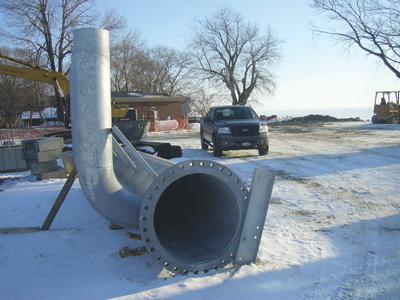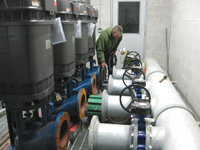
The Leamington Area Drip Irrigation group, featured in a cover article
in the September/October 2009 issue of Fruit & Vegetable Magazine,
was awarded the $100,000 2010 Premier’s Award for Agri-Food Innovation
Excellence.
The Leamington Area Drip Irrigation group, featured in a cover article in the September/October 2009 issue of Fruit & Vegetable Magazine, was awarded the $100,000 2010 Premier’s Award for Agri-Food Innovation Excellence.

|
| The LADI pipe can deliver up to 6,300 gallons per minute to fields but the system will only need to run at 5,600 gpm to serve the organization’s current member farms. Submitted photo Advertisement
|
The award, which recognizes the group for improving water efficiency by constructing a pipeline for a communal irrigation system, was presented during the sixth annual Premier’s Summit on Agri-Food, held in early April.
“Ontario’s farmers, agri-food business and rural communities continue to show outstanding leadership when it comes to innovation,” said Carol Mitchell, Minister of Agriculture, Food and Rural Affairs. “Through these awards, we recognize their outstanding creativity and contributions to the good things that grow in Ontario.”
Leamington Area Drip Irrigation (LADI) is a group of 13 farmers/farms – Palichuk Farms, Tiessen Farms, Lehn Farms, Len Driedger, Ken Hamm, Pete Brunatto, Glen and Todd Waites, Greg Dick, Lycoland Farms, Stasko Farms, Ken Epp, Triple K Farms and Tom Dick – who wanted to improve water efficiency for their operations.

|
| Four 150-hp electric pumps bring the water to the main pump house of the system. At this point, the water is chlorinated to keep zebra mussels from blocking the pipeline. Submitted photo
|
They spent years consulting with agencies and specialists across Canada, using that expertise to design and construct a new communal irrigation system that increases the reliability of supply and quality of water to local producers.
It also took $6 million to $1.9 million from the federal government and the rest raised through mortgages on the farmers’ properties – to pay for the project.
The 36-kilometre pipeline, pump house and filter system can precisely monitor the amount of water being delivered from Lake Erie to 2,500 acres of tomatoes in the Leamington area. Participating growers have seen a reduction in energy and input costs and an increase in the quality and yield of their crops. The fixed structure eliminates the need for much of the annual set-up associated with traditional drip irrigation and has reduced water costs in the growing season by 66 per cent.
“We take the impact on our local water resources very seriously,” Palichuk said when interviewed for Fruit & Vegetable Magazine’s 2009 article. “In fact, one reason we wanted this project was so that we could stop using Leamington’s municipal water supply, which has been suffering shortages due to all the demand. Now, we are off that system, and using no more than 20 gallons per minute per acre thanks to the drip method. To put this another way, an area that receives four hours of dripped water every day for seven days gets the equivalent of one inch of water. That’s within the guidelines that cities are recommending to residents for watering their lawns responsibly.
“LADI is a great example of what can be done when people come together. And it sure is a comfort when the rains don’t come – not this summer (2009), perhaps, but in the years ahead.”
Print this page